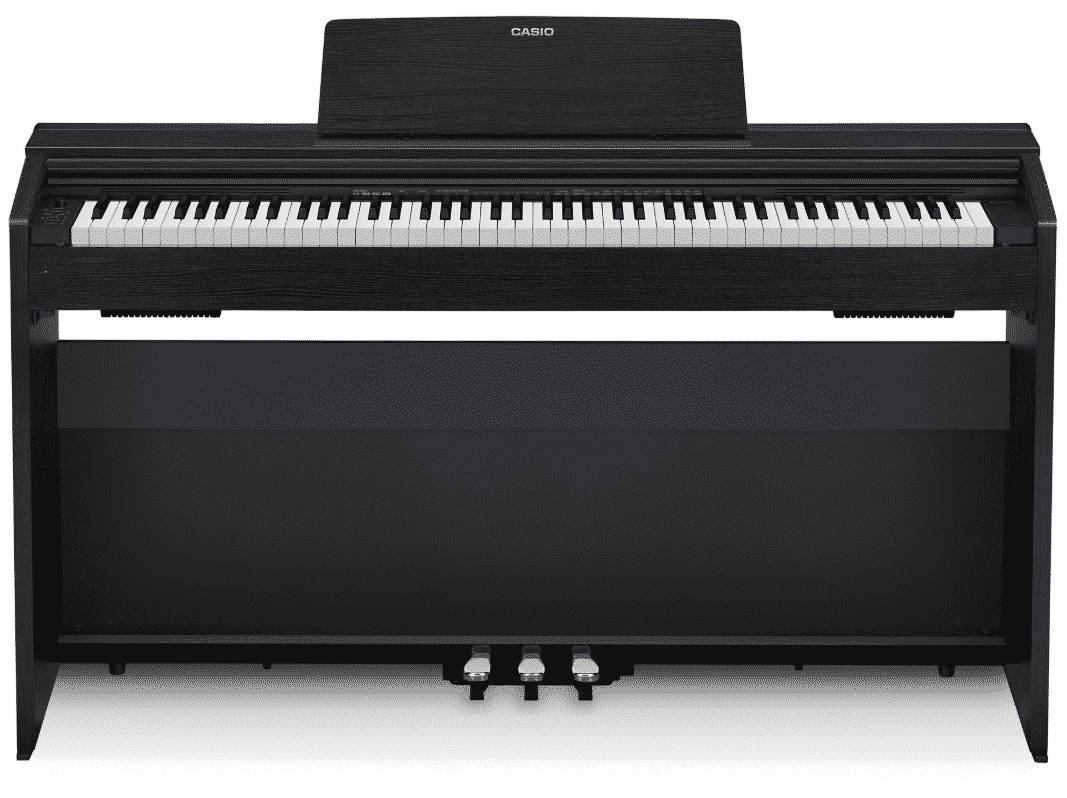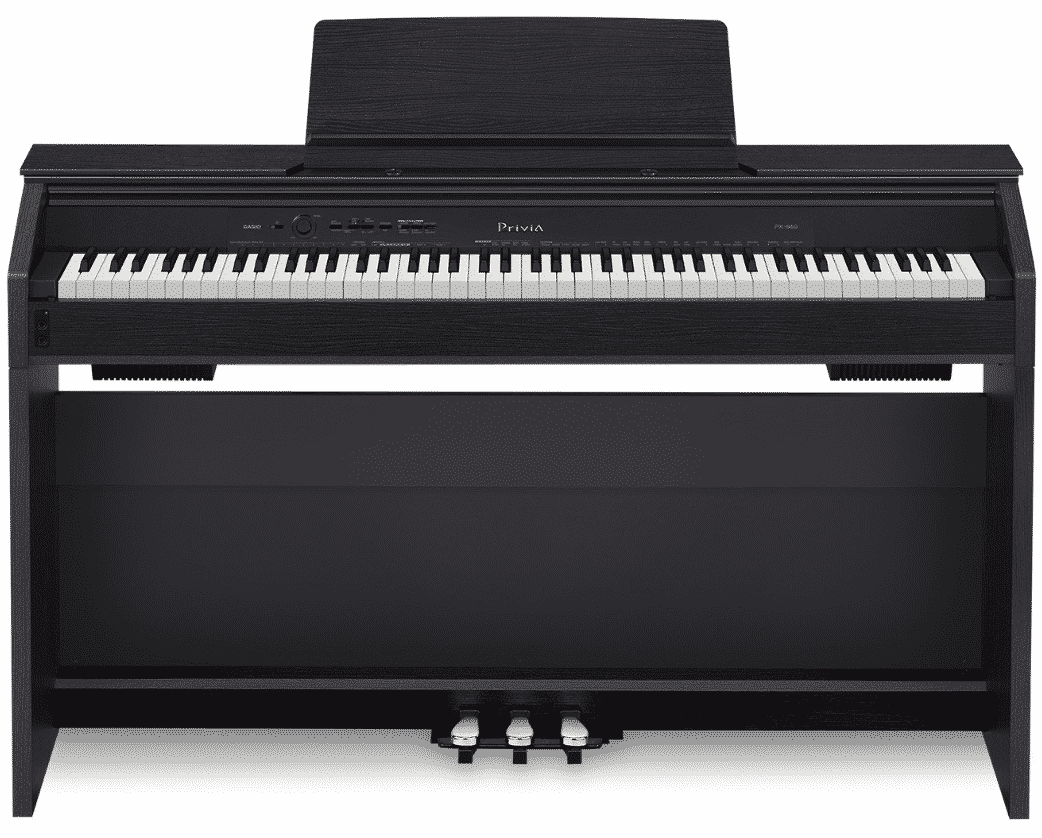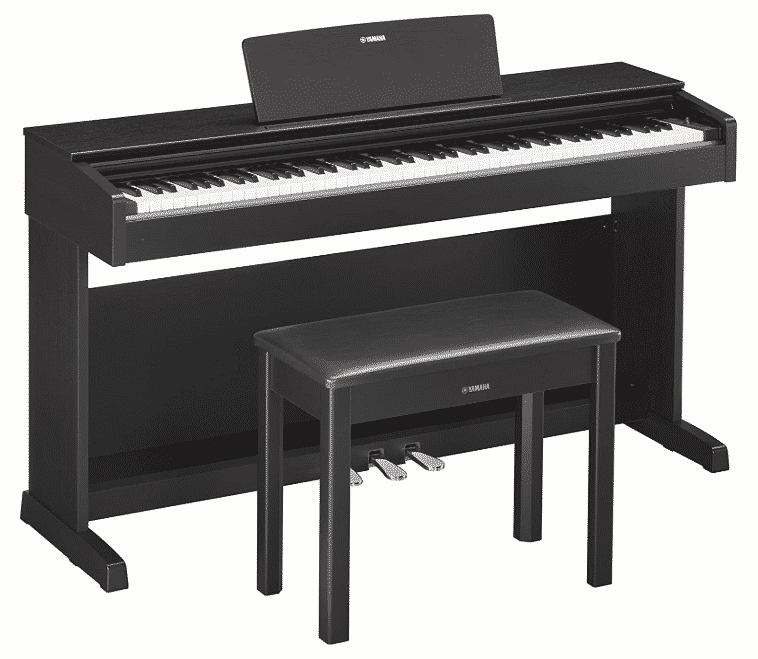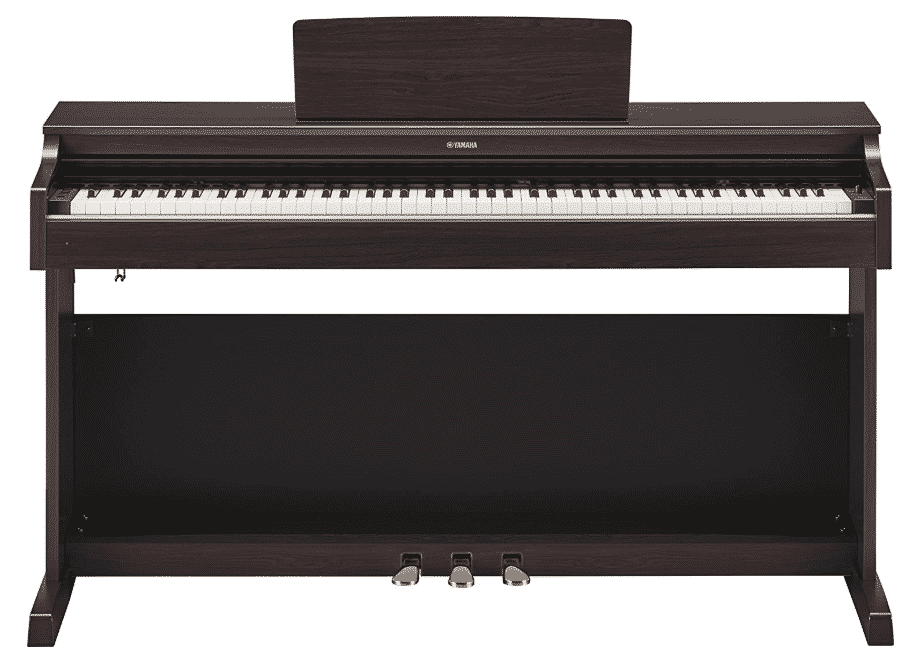Greeting to all piano avid, we are more than excited to bring you the new child in the Privia series of Casio piano – The Casio PX-870 review.
Being the flagship in the Casio’s Privia PX collection, the 870 model offers a whole lot of new key feature to the game. You won’t believe how it’s going to wow you in the end.
Though PX-870 is just one of the many sons from the brand, it has shown quite some impressions to the community.
Since the manufacturer has their intention to aim groups of customers, you may wonder the PX-870 is whether for a first-timer or an experienced player.
You will find out everything in our detailed review today.
Stay tuned.
The Casio PX-870 Overview
This is a premier instrument in Casio Privia line of digital pianos.
It combines the incredibly authentic piano sound and feels with the elegance that compliments any record. The Casio PX-870 delivers a superior piano experience.
Casio PX-870 Specs And Features
- Scale: 88-key fully-weighted keyboard with simulated Ivory & Ebony keytops
- Sensitivity: 3 levels
- Sensor: Tri-sensor Scaled Hammer Action Keyboard II
- Sound: Multi-Dimensional Morphing AiR Sound Source
- Note: 256-unit polyphony
- Tone: 19 instrument sounds (Grand Piano (Concert, Mellow, Bright), FM E. Piano, 60’s E. Piano, Modern Piano, Elec Piano 1, Elec Piano 2, Jazz Piano, Harpsichord, Vibraphone, Strings 1, Strings 2, Jazz Organ, Pipe Organ, Rock Piano, Elec Organ 1, Elec Organ 2, BASS (LOWER)
- Effects: Damper Resonance, String Resonance, Hammer Response, Key Off, Lid, Key On/Off Action Noise.
- Mode: Split, Dual, Duet
- Pedals: damper, soft, sostenuto
- Lesson: separate hand practice
- Recorder format: WAV (44.1 kHz, 16 bit, stereo)
- Hardware: Metronome, Transpose, Fine-tuning, Octave shift
- Temperament: 17 types
- Speakers: dual 20W
- External connectivity: USB to Host and Device, two Headphone jacks, and a Pedal Connector
- Dimensions: 54.8 x 11.7 x 31.5 in inches
- Weight: 75.6 lbs
- Warranty: extendable 3-year manufacturer’s warranty when registered
What Do People Say About The Casio PX-870?
Speaking about Casio, instrument may not come to the mind of amateurs at the first place. Only people in the trade are acknowledged of the high-end pianos it has brought to the industry.
Let’s grab the chance down the road to look into the instrument; you can determine whether it’s good or not at the end.

Design
Casio PX-870 has a design of a furniture-style piano. The full-fledged keyboard of 88 keys comes with three pedals making it too tough to move.
In the Privia series, the PX-870 works like a home piano. In spite of its bulky tendency, it doesn’t take up space as an actual grand piano.
It has a weigh of 75 pounds making it a heavy guy. The elegant design comes from the fiberboard structure and sleek finishes with black and white giving it a privileged look. It is styled with wooden texture for a realistic sense.
The previous brother of PX-870, which is PX-860, requires opening the lid to let the sound emit. This new version allows sound to come out without lifting the cover.
It is the new projective sound system consists of four speakers with a long narrow speaker-grill that helps the flowing sound.
The improvement also enables you to set up lamps and music sheets at ready thus promoting your living space. Though the piano will be delivered in a huge box of parts, the assemblage is quite easy
All you need is a screwdriver to put everything together following the Casio PX-870 manual in less than an hour.
After the Casio PX 870 assembly, you should have a shining piano that sounds right. Because the PX-870 resembles an acoustic guitar, three pedals are coming in the box.
One of them is the half-pedal operation giving a feeling like playing on an acoustic piano. This piano is available in black and white for your preference.
As a whole, it will be a majestic hot spot enlightens your room.
Highlight Functions
Keyboard
The PX-870 is well-known for the 88 full-size keys.
The keyboard features Tri-sensor Scaled Hammer Action Keyboard II with the actual hammer that elevates the acoustic sound with decent quality.
The touch-sensitive keys affect the volume at three levels. That means depending on how hard you press, you get different loudness.
The graded keyboard is designed to have a relatively lighter feel on the right while progressively heavier on the left.
Control Interface
The control elements located on the left side of the piano giving a less cluttered look making it easy to navigate.
To access the main sound, there are eight buttons to switch on the including the metronome and recording functions.
There is also a volume knob like on any electric piano. Each button comes with a label to ease your handling.
The downside of these switches is the beep sound that seems to imitate a toy-like noise.
According to the function you select, there will be more than one beep to hear.
It should be better if they can put a display on the board
Sound
A significant enhancement of sound has been brought to this newcomer of the Privia line.
The Casio PX-870 has an impressive sound from the 4-layer piano tone. You will hear rich sound with a specific thickness and fantastic natural decay.
The Multi-dimensional Morphing AiR Sound Source distributes to the smoothness and pleasant tone obtained from the grand piano of 9 feet long. There is no doubt with this world’s famous sound engine from Casio.
Tone And Sound Effects
Although the PX-870 only packs with 19 tonal effects in total, they all sound quite authentic.
These tones utilize the Air technology to offer the purest pitch; they are even more exceptional in quality.
To bring the experiences alive, the PX-870 brings 40-watt stereo sound projection system.
Of course, you can practice in quietness with two headphones (not included in the bundle).
Play Mode
The PX-870 features Casio’s Concert play mode allowing you to practice or perform along with the symphony orchestra.
Besides, the Lesson Mode offers 60 lossless songs to play along. Piano starters can mute one hand’s part to ease the practice.
Connectivity

If you want to practice along with this piano, the internal storage allows 10 MIDI song to be uploaded.
Moreover, its sizeable built-in memory contains a massive library of lossless audio.
With the sharpest accuracy, these compressed media provide with the most natural resonance, strings and note decay.
For beginners, the features like recording and playback will be useful in keeping your track.
The recorded files are saved in WAV and can be transferred to USB to play on a computer.
This digital piano is compatible with both Mac and Window.
It can also connect to the iOS and Android devices via USB-C port with no hassle installing
Modes Explained
Dual: generating two layers of sound simultaneously. The balance is adjustable.
Duet: splitting the keyboard into two section with two C in the middle of each. This is an ideal function for 1-0-1 teaching.
Split: dividing into two keyboards with assignable tone on each sign.
Price Tag
It’s fair to say that most people are happy with the range Casio has set for this piano. Casio PX-870 price falls at under $1000 when discounted, and it comes with a 1-year warranty.
It’s even better when you can get the extension of the warranty for two more years if registered.
Inside The Box
- 88-key furniture-style piano.
- Music stand
- A scorebook
- AC Power Adapter
- Manual
Things We Like
- Elegant appearance
- Compact size stands snuggly in one corner
- Three piano pedals and a half-pedal function like on an acoustic piano
- Built-in 19 tones
- 256 units of polyphony
- Audio and MIDI recorder
- Excellent keyboard with Hammer Action of synthetic ivory texture
Things We Don’t Like
- Bulky and not portable
- Control buttons have no display
- The key action is a bit noisier
Casio PX-870 Demo
Here is the Demo for you to watch the player plays this PX-870 in different modes and how versatile the instrument is.
A Brief Comparison To Other Pianos In The Same Line
Casio has surprised their customers with the exceptional seriousness in not only digital watches but also the instrument. The assumption has been proven in this PX-860.
To clarify the strength and weakness of the 870, let’s put it to an analyzation with other models.
Casio PX-870 Vs. Casio PX-860

The best way to see the improvement in the new release is to compare the differences with the last version.
When looking at Casio PX 870 vs. 860, we can see that the quality has been proven already in the 860.
In the 870, Casio has brought more technology and improvements.
Casio PX-860 dimensions are about the same with the upgraded keyboard. In other words, they remain the compact size on the 870 model.
The foremost visible feature is the 40-watt, 4-speaker Sound Projective system providing more realism than it was on the 860.
That means the sound emanates from four directions embracing the player encouraging more playable mood. The added volume sync further improves the sound at low range.
The appreciated feature on the 870 is the concert hall simulation giving players the sense of playing in a spacious space with sufficient echo for large rooms like classrooms or churches.
The keyboard also takes a leap in crafting the synthetic ebony and ivory keytops for a more comfortable feel on your fingertips.
The cabinet now has fewer seams but the better impression from the exterior.
The control panel is relocated to the left for more convenient maneuverability.
If you are a player of the PX-860 with frustration about its limitation, an upgrade to 870 will make you happy.
Vesus Casio PX-770

Casio PX-870 vs. PX-770 sounds unfair, but you should notice that these two models share some similarities.
They are both credited for authentic feel and concept.
They use the same scale of 88 keys weighted hammer action with levels of sensitivity.
The design of the two is alike with cabinet and three pedals, duet mode as well as stimulated ebony and ivory textured keys.
But there should be noticeable distinguishes.
While the PX-770 stops at 128 note polyphony, 870 takes it up to 256 notes with string resonance, lid simulator, and adjustable hammer. These things are not available in the PX-770.
So, if it doesn’t bother your budget for a more high-end instrument, there is no reason why you ignore the Casio PX-870. You can read my Casio PX 770 review for more detail.
Casio PX-870 Vs. Yamaha YDP 143

In the competition of digital piano, Casio and Yamaha are the giants in the industry.
At the price point, Casio can beat the competition for better money.
While the Yamaha YDP 143 is pretty for the entry level with the GHS keyboard that only bears two sensors, Casio has three. That implies a better keyboard.
The ability to detect sensibility in the Casio is more responsive to more variables.
Casio PX-870 owns four speakers whereas YDP only has 2. The difference will be audible.
Yamaha is said to have a sturdier build and decent longevity in quality. But the Casio appears to be a more powerful instrument to invest in.
Take account of the design; the Yamaha sets the piano’s control on the right while the Casio’s is on the opposite side.
It depends on your preference whether on which side you feel more comfortable.
In term of the pedal, the two have three dampen pedals. Similarly, they all provide half-pedal control for the realistic of an acoustic piano.
When it comes to considering these two pianos, it is best to test them out before deciding.
They both make good pianos for entertaining and learning purpose.
Yamaha YDP-163 Vs. Casio PX-870

YDP 163
These instruments are in the same class of pianos under $1500.
This budget is quite healthy but confusing for any who wants to own a piano in the group.
Yamaha pianos at this range offer the Graded Hammer System while Casio provides their note hammer action both giving the equilibrium in sound and feel.
The YDP-163 owns the full onboard speaker, not like the 4-speaker system on the PX-870.
And again, the Yamaha loses the race of polyphony unit with only 192 notes.
To make up for the fewer note polyphony, you can find the professional Clavinova range in every press. However, the Casio PX-870 is a more responsive keyboard compare to the hard-to-beat key on the Yamaha YDP-163.
Also, the PX-870 is powered with the AiR sound system offering the genuine, realistic tonal shift.
All in all, the YDP-163 and PX-870 will give you a hard time to determine. But you will soon realize that at the same quality, the piano from Casio is more affordable.
Casio Privia PX-870 In Conclusion
With the money in the wallet less than $1000, Casio PX-870 will score your impression.
We give our verdict of 9 over 10 for the following reasons:
Casio has the best technology in the industry that is only available in high-priced instruments. The Privia series is an advanced line that only offers high-quality digital pianos for beginners and skilled players.
Their pianos utilize top-notch samples of concert piano to bring the string resonance, damper resonance, key on/off action noise to provide as much authenticity as possible.
Not to mention the 870 model is the newest release in the Privia line using all best features that Casio is proud of including the Tri-sensor Hammer Action Keyboard II, the 40W sound system of 4 speakers.
You can only find 256-note polyphony on $2000+ pianos, but the PX-870 has brought the feature here in a can’t-be-better deal.
The recorder function enables you to save and listen to your practice in WAV and MIDI format. You can now share your moments or play it back to improve the technique.
The 88-key scale allows you to invite one more player to have a duet. And so much more great features need you to discover once you get your hands on and there is no need to labor the point.
Admittedly, people complain about the portability of the PX-870. But there should be no point since you don’t want to move it around frequently.
The track recorder can only store ten files at a time; so, it’s relatively limited storage.
Nonetheless, you will have an intensive piano giving the closet to the acoustic instrument. Despite all the minor drawbacks, beginners benefit from this piano effectively.
The instrument has the ability to keep up with your growth and establishment of style. Advanced pianists may not find this piano in much of a help.
It is not an inspiring piano for its lack of accompaniment patterns and rhythms.
But for an impromptu performance, it appears to function elegantly. Altogether, the Casio PX-870 is an exceptional and unique instrument.
